Decentralized Control of Uncertain Fuzzy Large-Scale System with Time Delay and Optimization
Abstract
This paper studies the decentralized stabilization problem for an uncertain fuzzy large-scale system with time delays. The considered large-scale system is composed of several T-S fuzzy subsystems. The decentralized parallel distributed compensation (PDC) fuzzy control for each subsystem is designed to stabilize the whole system. Based on Lyapunov criterion, some sufficient conditions are proposed. Moreover, the positive definite matrices Pi and PDC gain Kij can be solved by linear matrix inequality (LMI) toolbox of Matlab. Then, the optimization design method for decentralized control is also considered with respect to a quadratic performance index. Finally, numerical examples are given and compared with those of Zhang et al., 2004 to illustrate the effectiveness and less conservativeness of our method.
1. Introduction
Many real-life problems, such as power system, economic systems, societal system, and nuclear system are frequently of high dimension. Such systems are regarded as large-scale system. They consist of a number of subsystems which serve particular functions, share resources, and are governed by a set of interrelated goals and constrains [1]. Over the past decades, many methods have been to investigate the stability and stabilization of large-scale system [2–10].
Fuzzy systems of Takagi-Sugeno (T-S) models [11] have become an effective method to represent complex nonlinear dynamic system by fuzzy sets and fuzzy reasoning. The method of T-S model is feasible since, in many situations, human experts can provide linguistic descriptions of local systems in terms of IF-THEN rules [12–14]. Reference [15] proposed a control concept “parallel distributed compensation” (PDC) for fuzzy controller design of T-S fuzzy model. Under some conditions, PDC can stabilize the closed-loop fuzzy system asymptotically. Linear matrix inequalities (LMIs) methods to find the common positive matrix Pi always play a key role work in PDC design [16].
Now let us consider the control problem of large-scale system. Accordingly, suppose a large-scale system is composed of a number of subsystems with interconnection. Each subsystem is described by a T-S fuzzy model. That is, each subsystem dynamic is captured by a set of fuzzy implications that characterize local relations in the state space. Then, the global model of large-scale system can be achieved by smoothly connecting the local linear model in each fuzzy subspace together via the membership functions. Recently, the fuzzy decentralized control design methods and stability condition are addressed [17–24]. Wang and Luoh [17] have studied a fuzzy decentralized control design method for a fuzzy large-scale system on the assumption that all variables are available. Tseng and Chen [18] dealt with the model reference tracking control problem by using H∞ decentralized fuzzy control, which relaxed the condition that the state variables are measurable. Wang and Zhang [19] considered the robust decentralized controller design method for nonlinear large-scale descriptor system. Hsiao et al. [20] proposed fuzzy decentralized control design methods for fuzzy large-scale system with time delays and gave the analysis of the closed-loop fuzzy large-scale system. Robust decentralized H∞ output feedback controller was designed in [21]. Tong and Zhao [22] proposed a stabilization criterion of continuous-time interconnected fuzzy systems without uncertainties. Su and Liu [23] dealt with decentralized stabilization problem for a large-scale system in which the system is composed of several T-S fuzzy subsystems with nonlinear interconnections. Wang et al. [24] addressed robust H∞ fuzzy controller design to overcome the parametric uncertainties of fuzzy large-scale systems without time delay and get H∞ performance. Zhang et al. [25] proposed the stabilization problem of fuzzy large-scale system without parametric uncertainties.
However, the proposed decentralized control designs and the sufficient conditions of closed-loop system did not consider the parametric uncertainties or time delays, which is important in both theory and real-world application. In this paper, the stabilization problem of the uncertain fuzzy large-scale systems with time delays is considered. Based on decentralized control concept, we like to synthesize a PDC controller for each subsystem so that the whole system can be stabilized asymptotically. When applied to degenerated cases, (without uncertainties or time delay), the stabilization criteria are better than existing ones. Stability is one of the most important performance indecies, but it is not enough for control systems. Linear quadratic performance can reflect a lot of performance requirements, so a quadratic performance index is considered in this paper. Based on Lyapunov function stability theory, the optimization design method for decentralized control with respect to the quadratic performance index is transformed into solving linear inequality matrix by PDC controller.
This paper is organized as follows. In Section 2, the considered systems are stated and some preliminaries are presented.The problem of stabilization for fuzzy large-scale system with uncertainty is proposed in Section 3. Section 4 provides examples to illustrate the correctness of our theoretic results. Finally, a conclusion is given in Section 5.
2. System Description and Preliminaries
The main propose of this paper is to synthesize a decentralized PDC fuzzy controller ui(t) for each subsystem such that the closed-loop large-scale T-S fuzzy systems (2.1) is asymptotically stable and the optimization design method for decentralized control respect to the quadratic performance index.
Before starting the main results, we need the following lemmas.
Lemma 2.1 (see [26].)Let Q be any of n × n matrix; one will have for any constant k ≥ 0; and any positive matrix S > 0 that
Lemma 2.2 (see [26].)Let D, E be any constant matrices and FTF ≤ I, where a is a positive constant, all matrices with appropriate dimensions; one will have for any constant k > 0 such that
Lemma 2.3 (see [27].)Let Ri be any positive matrix; one will have for any 0 ≤ hij(t) ≤ 1 such that
3. Stabilization and PDC Synthesis of Fuzzy Large-Scale System
In this section, the decentralized concept and PDC approach are applied to synthesize a local feedback controller for each local subsystem. Let the fuzzy controller be as the PDC form:
Now, our work is to determine the local feedback gains Kij such that the whole fuzzy large-scale system (3.3) is asymptotically stable.
Theorem 3.1. The fuzzy large-scale system (2.1) can be asymptotically stabilized by the decentralized PDC fuzzy control (3.2), if there exist matrices Fij, positive definite matrices Xi to satisfy the following LMIs:
Proof. Let the Lyapunov functional be
Using Lemma (2.2), we have
So we have while xi(t) (i = 1,2, …, J) are not all zero vectors. Note that the matrix inequalities in (3.13) can be transformed into certain forms of linear matrix inequalities (LMIs). Therefore, multiplying both sides of matrix inequalities (3.13) by and applying the change of variables such that , , then (3.4) is obtained.
With the similar proof of Theorem 3.1, the stabilization criterion of large-scale system (2.1) without uncertainties is also discussed. The result is presented as follows.
Corollary 3.2. The fuzzy large-scale system (2.1) without uncertainties can be asymptotically stabilized by the decentralized PDC fuzzy control (3.2), if there exist matrices Fij, positive definite matrices Xi to satisfy the following LMIs:
Proof. The proof is similar with that of Theorem 3.1; therefore details are omitted.
Remark 3.3. This corollary is similar with Theorem 1 in [10], so the theorem in this paper is more general.
Theorem 3.4. If there exist matrices Fij, positive definite matrices Xi to satisfy the following LMIs:
Proof. From the proof of Theorem 3.1, we know if
4. Numerical Examples
In this section, some numerical simulations for uncertain fuzzy large-scale system will be given to illustrate the effectiveness of the proposed stabilization criteria and also compared with the existing results.
Example 4.1. Consider an uncertain FLSS time delays S composed of three fuzzy subsystems Si, i = 1,2, 3 by the following equations:
Here, the T-S fuzzy models of the isolated subsystem are of the following:
Subsystem 1
Rule 1. If x11(t) is M111 then
Subsystem 2
Rule 1. If x12(t) is M112 Then
Subsystem 3
Rule 1. If x13(t) is M113 then
Rule 2. If x13(t) is M213 then
It is noted that the above large-scale system without control (ui(t) = 0) has unstable responses with initial conditions x1(t) = [−3,3] T, x2(t) = [−2,2] T, x3(t) = [1, −1] T as shown in Figure 1.
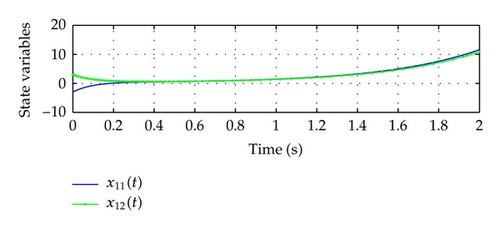
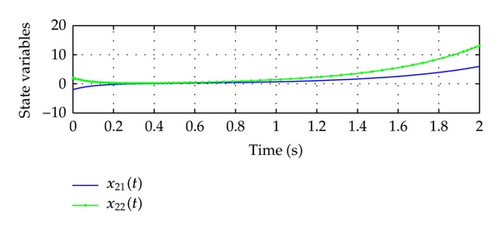
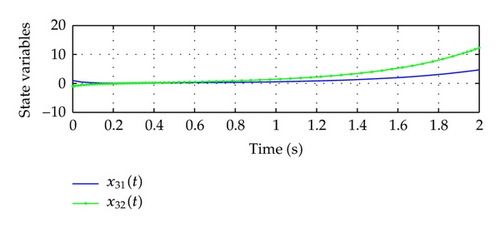
In order to stabilize the large-scale fuzzy system, three decentralized PDC fuzzy controllers are designed in the following.
Fuzzy Controller C1
Rule 1. If x11(t) is M111 then
Rule 2. If x11(t) is M211 then
Fuzzy Controller C2
Rule 1. If x12(t) is M112 then
Rule 2. If x12(t) is M212 then
Fuzzy Controller C3
Rule 1. If x13(t) is M113 then
Rule 2. If x13(t) is M213 Then
The complete simulation results with initial conditions x1(t) = [−3,3] T, x2(t) = [−2,2] T, x3(t) = [1, −1] T are shown in Figure 2. It is obvious that they are stabilized asymptotically.
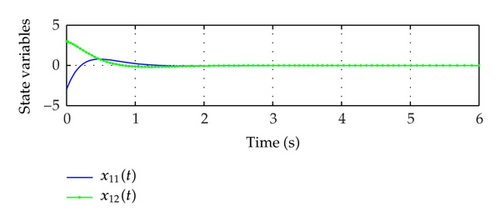

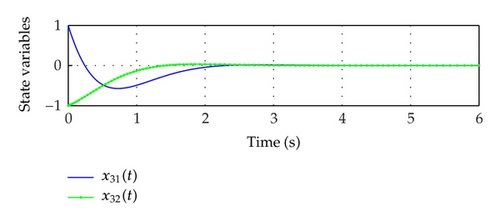
Example 4.2. Consider the fuzzy large-scale system S composed of two subsystems Si as follows [25]:
In order to stabilize the large-sale fuzzy system, three decentralized PDC fuzzy controllers are designed in the following.
Fuzzy Controller C1
Rule 1. If x11(t) is M111 then
Rule 2. If x11(t) is M211 then
Fuzzy Controller C2
Rule 1. If x21(t) is M112 then
Rule 2. If x21(t) is M212 then
The control gain Kij for subsystem S1, S2 is compared with [24] in Table 1. The complete simulation results with initial conditions x1(t) = [1, −1] T, x2(t) = [2, −2] T are shown in Figure 3.
| Index | K11 | K12 | K21 | K22 | J* | ∥K∥2 |
|---|---|---|---|---|---|---|
| Zhang et al. [25] | [10.7602 4.8931] | [7.1424 1.0899] | [2.2702 0.1348] | [1.9527 0.8715] | 21.0606 | 14.2011 |
| This paper | [9.0414 1.0000] | [2.0000 1.8284] | [1.1604 0.0740] | [0.3515 2.2722] | 12.2288 | 9.8351 |

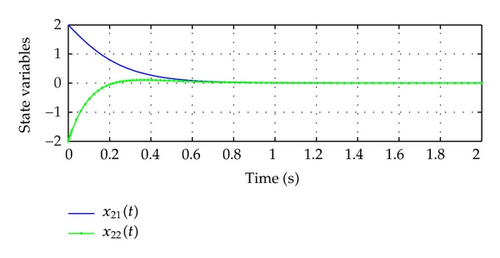
5. Conclusions
In this paper we explore the stabilization problems for uncertain fuzzy large-scale system with time delays. The decentralized PDC fuzzy controller has been designed under some conditions such that the whole closed-loop large-scale fuzzy system is asymptotically stable. Then, the optimization design method for decentralized control is also considered with respect to a quadratic performance index. Finally, numerical examples are provided to demonstrate the correctness and less conservativeness of the theoretical results. However, there are still some other problems to be addressed, such that time-varying delays and delay-dependent stability and stabilization of fuzzy large-scale system and the results developed in the paper can be extended to the case that the underlying systems are invovled with any switching dynamics.
Acknowledgment
This work is supported by the National Natural Science Foundation of China (60774045, 61075065).




